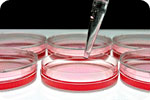 This particular e.coli variation is a member of the O104 strain, and O104 strains are almost never (normally) resistant to antibiotics. In order for them to acquire this resistance, they must be repeatedly exposed to antibiotics in order to provide the "mutation pressure" that nudges them toward complete drug immunity.
This particular e.coli variation is a member of the O104 strain, and O104 strains are almost never (normally) resistant to antibiotics. In order for them to acquire this resistance, they must be repeatedly exposed to antibiotics in order to provide the "mutation pressure" that nudges them toward complete drug immunity.
So if you're curious about the origins of such a strain, you can essentially reverse engineer the genetic code of the e.coli and determine fairly accurately which antibiotics it was exposed to during its development. This step has now been done (see below), and when you look at the genetic decoding of this O104 strain now threatening food consumers across the EU, a fascinating picture emerges of how it must have come into existence.
So how, exactly, does a bacterial strain come into existence that's resistant to over a dozen antibiotics in eight different drug classes and features two deadly gene mutations plus ESBL enzyme capabilities?
There's really only one way this happens (and only one way) -- you have to expose this strain of e.coli to all eight classes of antibiotics drugs. Usually this isn't done at the same time, of course: You first expose it to penicillin and find the surviving colonies which are resistant to penicillin. You then take those surviving colonies and expose them to tetracycline. The surviving colonies are now resistant to both penicillin and tetracycline. You then expose them to a sulfa drug and collect the surviving colonies from that, and so on. It is a process of genetic selection done in a laboratory with a desired outcome. This is essentially how some bioweapons are engineered by the U.S. Army in its laboratory facility in Ft. Detrick, Maryland (http://en.wikipedia.org/wiki/Nation...).





 Toothpaste can be widely contaminated with lead and other dangerous heavy metals, new research shows.
Most of...
Toothpaste can be widely contaminated with lead and other dangerous heavy metals, new research shows.
Most of... CT scans diagnose afflictions from tumors to kidney stones to life-threatening diseases and injuries, such as...
CT scans diagnose afflictions from tumors to kidney stones to life-threatening diseases and injuries, such as...






























